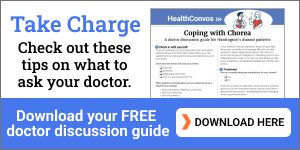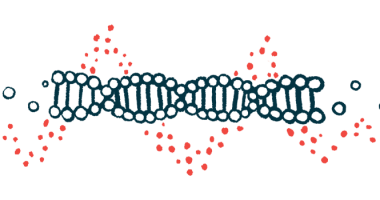Essential adaptive devices and technologies for Huntington’s
Last updated Jan. 15, 2025, by Susie Strachan

Adaptive devices can improve life with Huntington’s disease by helping to support mobility, communication, and daily tasks including eating and bathing.
Huntington’s disease affects both body and mind by causing symptoms such as involuntary muscle movements, memory difficulties, and emotional changes.
Home adaptations and other assistive devices can provide stability and make living spaces safer and more accessible.
How adaptations and assistive technologies help
The progression of Huntington’s is not the same for every person living with the disease.
For some, cognitive changes may happen more quickly, while their ability to control movement might remain somewhat stable for a period of time. For others, the progression of movement difficulties may be more rapid, but their cognitive skills may remain relatively unaffected for longer.
Generally, Huntington’s disease symptoms progress through three main stages: early, middle, and late, which can be further divided into substages.
- In the early stages, subtle motor issues such as chorea, which are involuntary muscle movements, can occur, but many people maintain their independence and ability to manage day-to-day tasks.
- In the middle or intermediate stage, chorea becomes more severe and cognitive challenges or psychiatric symptoms may also begin, increasing the need for some assistance with daily activities.
- During the late or advanced stage, people may require full-time care due to more severe motor and cognitive impairments and other issues, such as swallowing problems.
By choosing the right aids at the right time, people living with Huntington’s disease and their caregivers can manage life more effectively and have a better sense of control even as symptoms progress.
In the early stage, tools like ergonomic utensils, weighted cups, and simple memory aids can help maintain your independence and minimize frustration.
In the middle stage, mobility aids including walkers or wheelchairs may be needed for safety and stability. Communication devices can assist with speech difficulties, while home modifications, such as grab bars and stair lifts, provide a safer environment.
In the late stage, the focus shifts to full-time care and comfort. Adaptive aids such as specialized mattresses, feeding tools to address swallowing challenges, and mechanical lifts for transfers can lessen the physical strain on caregivers while ensuring your safety and dignity.
Work with your care team on a plan that introduces adaptive aids as part of your Huntington’s disease treatments.
Healthcare professionals such as physical and occupational therapists can help you choose the right devices, including for home adaptations. Speech therapy can be a way to learn more about assistive technology for communication.
Mobility devices
Chorea is usually one of the main symptoms of Huntington’s and may cause difficulty with balance and walking. Another movement-related condition seen in Huntington’s is called bradykinesia, defined by abnormal slowness of movement.
Chorea and bradykinesia may lead to a slow, wide-based walking pattern as a way to compensate for balance issues. Using mobility aids like trekking poles or a walker can make it easier to move more safely.
A physical therapist can advise on the best walker or rollator for your needs, and they may also suggest footwear with good grip to prevent falls.
As muscles weaken, staying upright may become more difficult. Reflexes may become slower, increasing the likelihood of stumbling or falling. If this happens, you may want to try a wheelchair.
A physical therapist can help you find a wheelchair that works best for you, especially if you’re struggling with controlling your movements and have muscle tightness and balance issues.
Mobility advice for caregivers
If you are a caregiver for someone with Huntington’s, you may notice cognitive difficulties that are affecting their mobility.
Cognitive decline can make it more difficult to do complex tasks such as walking, navigating spaces, or performing movements including sitting or standing.
When cognitive decline affects mobility, extra support may be needed. For example, if your loved one falls frequently, you may want to consider safety gear such as helmets, elbow and knee pads, and hip protectors.
If they can no longer move around using a walker, it may be easier to walk hand-in-hand with one or two caregivers. In cases where walking is no longer possible, a semi-reclining push chair with padding may be safer and more comfortable for mobility.
Communication and memory
Cognitive changes from Huntington’s disease can make it difficult to stay focused during conversations or express thoughts clearly, while increasing weakness in throat muscles can make it more difficult to speak.
As communication becomes more challenging, you may want to try augmentative and alternative communication (AAC) devices, speech-generating devices, and communication apps.
In the early stages, tablets or smartphones with communication apps may be useful, allowing you to type, select symbols, or use voice output to express your needs.
As Huntington’s symptoms progress, simpler tools like talking mats, word boards, or letter boards may be more effective. These devices allow you to point to words or images to convey basic messages.
Speech therapists can help you and your caregivers decide which communication aids are right for you at each stage of the disease.
Memory aids can also help you keep track of tasks and events, despite changes in cognition and memory. These can include using:
- a paper calendar to keep track of the days
- task lists to help break activities into manageable steps
- reminder apps to alert you about events
- pictures or symbols on a communication board to indicate daily routines
- visual cues such as labels on cupboards or drawers to help locate items more easily.
Adaptations for daily living
As Huntington’s disease progresses, tasks that were once routine, such as dressing, eating, and bathing, can become more difficult. But there are ways to improve your safety, comfort, and independence.
Using specialized devices, such as supportive seats, adjustable beds, utensils designed for easier grip, and bathroom aids, can help you better manage everyday tasks.
Eating meals
Eating and swallowing may become increasingly difficult as motor control weakens from Huntington’s disease, which can make it harder for you to get proper nutrition and lead to weight loss.
In the early and middle stages of Huntington’s, motor issues may cause you to spill food or drop utensils. Adaptive aids can make meals easier and more manageable, such as:
- weighted or specially shaped utensils for better grip
- nonslip mats to keep dishes in place
- spill-proof cups or cups with built-in straws
- plate guards to prevent food from falling off the plate.
As Huntington progresses into the later stages, swallowing difficulties may become more severe. Symptoms such as coughing, gagging, or drooling can further complicate eating.
If you are a caregiver, you may want to talk with a speech therapist for recommendations, such as chopping or pureeing foods and using thickening liquids to make these easier to swallow.
When swallowing is no longer possible, a gastrostomy (feeding) tube may be required to ensure nutritional needs are met.
Using the bathroom
Bathroom tasks, such as bathing or using the toilet, can become difficult for people with Huntington’s disease due to balance issues, limited motor control, and the risk of falling.
Assistive devices that can enhance overall safety, particularly while bathing, include:
- a shower chair to help with balance and stability
- a hand-held shower head to minimize movement
- bath mitts, which fit over the hand and eliminate the need to grasp soap or a washcloth.
Other useful assistive devices in the bathroom include:
- grab bars and safety rails installed near tubs, showers, and toilets
- elevated toilet seats with a safety frame
- nonslip mats in the shower or tub.
Getting dressed
Tasks such as fastening buttons, pulling zippers, and tying shoelaces can become increasingly difficult for people with Huntington’s due to challenges with fine motor control and hand movements.
Choose clothing that is easy to put on and take off, with loose-fitting designs that have elastic waistbands and Velcro fastenings, along with slip-on shoes.
Huntington’s can make you feel too warm, often because the disease can make it harder for your body to regulate its temperature. Light, breathable fabrics and layering easy-to-take-off clothing can help with staying comfortable throughout the day.
An occupational therapist can recommend specific clothing adaptations or assistive devices that can help you get dressed.
Supportive seats
It may become difficult to sit in a standard seat as involuntary twisting and arching movements can cause you to slide or slip out of the chair.
It can be helpful to choose a chair that has a tilted seat with the front higher than the back, which positions your knees higher than your hips when seated. Or a tilt can be created using wedge-shaped cushions in your chair.
Sleeping
Problems with sleep are common in Huntington’s disease and can be made worse by the involuntary movements, muscle rigidity, and changes in posture from the condition.
Assistive devices can help you stay positioned in bed, manage movement-related discomfort, and prevent falls during the night.
- Adjustable bed rails can provide a barrier, reducing the risk of falling out of bed while sleeping.
- Adjustable beds that can be lowered closer to the floor can reduce the risk of injury if you do fall out.
- Anti-slip pads or mats can help keep bedding in place and make transferring in and out of bed safer.
- A pressure-relief mattress and cushions can help reduce movement-related discomfort.
Home adaptations
Involuntary movements, balance issues, and cognitive changes caused by Huntington’s can increase the risk of accidents and being injured. Home adaptations can help address them.
Adaptations can range from more simple changes, such as clearing clutter and securing rugs to prevent tripping, to installing grab bars, stair lifts, and adjustable furniture.
If you are a caregiver, and your loved one has cognitive issues, additional precautions may be needed, including:
- lowering the water heater temperature to prevent scalding injuries
- restricting access to areas with potential hazards, such as the kitchen, by using locks or barriers
- storing medications and household cleaners out of reach, or in a locked cabinet, to avoid accidental misuse.
An occupational therapist can offer additional recommendations for making home a safer and more supportive environment.
Huntington’s Disease News is strictly a news and information website about the disease. It does not provide medical advice, diagnosis, or treatment. This content is not intended to be a substitute for professional medical advice, diagnosis, or treatment. Always seek the advice of your physician or other qualified health provider with any questions you may have regarding a medical condition. Never disregard professional medical advice or delay in seeking it because of something you have read on this website.
Recent Posts
- How to support someone who is planning for future care
- Antipsychotics improve functional capacity, independence in HD
- Despite dwindling resources, hope endures among researchers
- The ‘invisible’ symptoms of Huntington’s that people don’t see
- Genetic variant delays Huntington’s onset by up to 23 years: Study
- Watching Huntington’s switch roles in our marriage was jarring
- The gift of community is what I’m most thankful for this year
- Revir wins $4.6M grant to advance oral Huntington’s treatment
- The inheritances that shape how we love, lead, and live
- Listening to my body without shame when it says, ‘Rest’
Related content





